6. BIOFABRICATING MATERIALS¶

A collaborative works by Ruby Lennox, Maria-Rigina Chatzivalasi, Julija Karas, Hala Amer, ChungHan Lu with mentorship from Petra and Julia.
INSPIRATION¶
AMAZING PROJECTS & MATERIALS"¶
- Papaver dress - poppy seed biomaterial
- Poppy bioleather, internal silk and cashmere structure. Colored with pink clay.
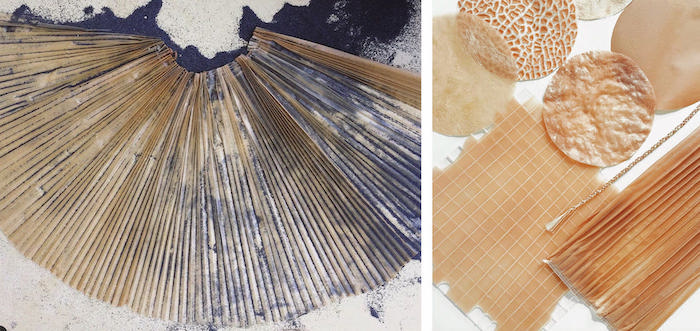
- The mycelium and algae co-cultivation - project Mind the Fungi
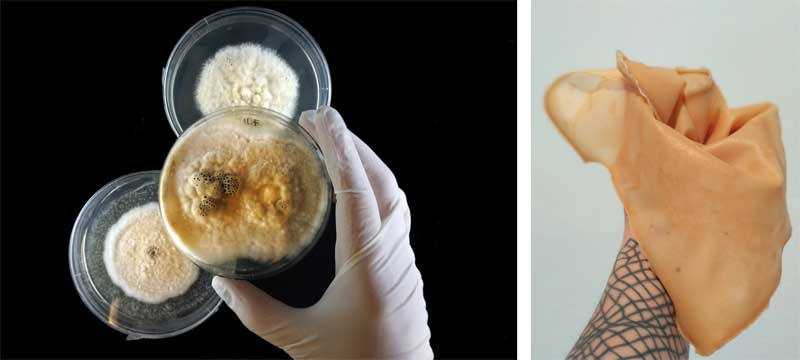
- Biblioteca de biomateriales.

- An experimental approach for packaging by Emma Sicher.
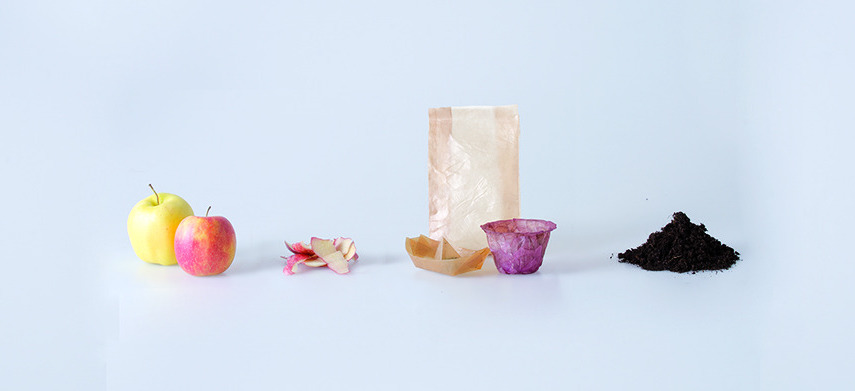
Alumni's pages as an inspiration¶
RESEARCH¶
Terminology¶
| Bioplastic | a biobased polymer desived from a biomass. It is comprised of a biopolymer, plasticizer, and a solvent. |
| Polymer | assemblies of identical chemical subunits, called monomers, that are linked together in the form of a chain. |
| Biobased | Made of bacteria, fungi, mineral, vegetal, biosyntehtic, and animal. |
| Biodegradable | Degrades in specific conditions like pH sensitive environments, thermo sensitive, and enzymes. |
| Biocompostable | composted in 90 days like bacteria, mycelium, animals, etc. |
| Crafted | Casted, extruded, and/or assembled. |
| Grown | from scratch like fingii, microbial, and lab grown leathers. |
BOOKLETS¶
GENERAL RECIPES¶
| PLASTIC TYPE | SODIUM ALGINATE (strings) | GELATINE | AGAR AGAR | STARCH | PINE RESIN | SODIUM ALGINATE (casting) |
|---|---|---|---|---|---|---|
| POLYMER | 4g | 48g | 10g | 60g | 45g | 4g |
| SOLVANT | 200ml water | 240ml water | 300ml water | 300ml water & 60ml vinegar | 20ml ethanol | 200ml water |
| PLASTICIZER | <30g glycerol | Glycerol: Rigid:0g ; Normal:24g; Elastic: 48g | Glycerol: R:4g N:16g; E:32g | Glycerol: R:Og; N:40g; E:80g | 5gr carnauba wax | Glycerol: N:10g; E:30g |
| HEAT / COLD | COLD, solidify with calcium chloride 30g, 300ml water | Heat (simmering) | Slow heat until changes - thickening, pulverizing | Heat then bake | Heat and add 40g filler (small particles - dried orange peel...) | COLD, solidify with calcium chloride 30g, 300ml water |
| MOLD TYPE | syringe | 3D printed molds | woven textiles, wood / laser-cut molds | woven textiles, wood / laser-cut molds | wood / laser-cut molds | woven textiles, wood / laser-cut molds |
TIPS FOR DIFFERENT RESULTS / TREATMENTS
-
Instead of water, use a leftover dye bath or add powder pigment while cooking to add color. Textures can be created by adding filler materials or casting on textured surfaces.
-
Here are some tips to make the gelatin transparent: First, mix the water and gelatin, and then add the glycerin later.
-
To prevent molding, you can use cinnamon or tannins. Additionally, adding alum can make bioplastics more water-resistant.
-
You can cast on a 'holographic' sheet for a structural color element. To make flat sheets, use a spatula or squeegee.
LOCAL WORKSHOP RECIPES¶
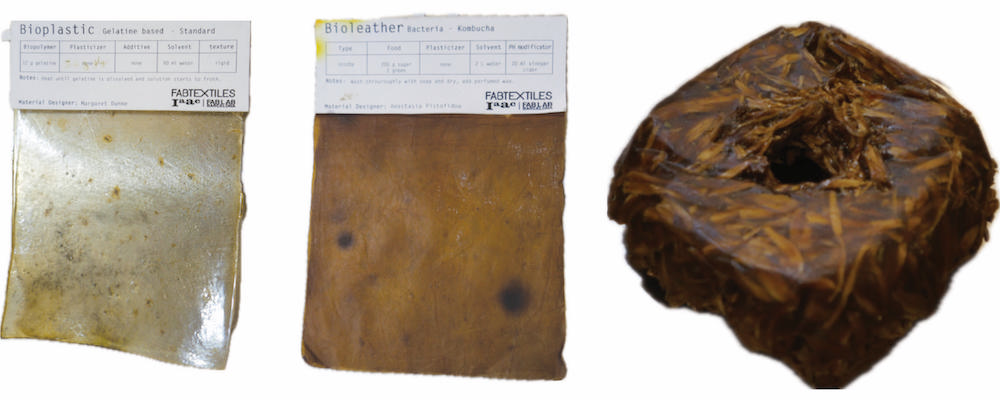
SODIUM ALGINATE (strings)¶
"The sodium salt from alginic acid and gum mainly extracted from the cell walls of brown algae. Brown seaweeds are usually larfe, and range from the giant kelp that is often 20m long, to thick, leather-like seaweeds from 2 - 4m long, to smaller species 30 - 60cm long." (Credit Material Archive TextileLab Amsterdam)
Special Characteristics¶
| Water Resistance | Sodium Alginate becomes water proof! Will only dissolve in alkaline water. |
| Heat Resistance | Withstands temperatures up to 150 degrees celsius. |
∙ 4g Sodium alginate
∙ 200 ml Water
∙ 10g - 30g Glycerol (according to the required flexibility)
∙ 30g Calcium chloride
∙ 300ml water
∙ Syringe (or any tool for making strings), spoon
∙ Cups and containers
∙ Hand blender / Mixing tools
∙ digital weighing scale
∙ Measure the Sodium alginate, glycerol and water and mix it.
∙ Measure the Calcium chloride and water and mix it.
∙ Pour water into a cup .
∙ Put the Sodium alginate mix into a syringe or another extruding tool.
∙ Press it carefully (try uniform pressure) into the Calcium chloride solution and then move it into the cup of water to rinse.
∙ Dry in a way that it touches the most air as possible, like hanging or on the mesh.
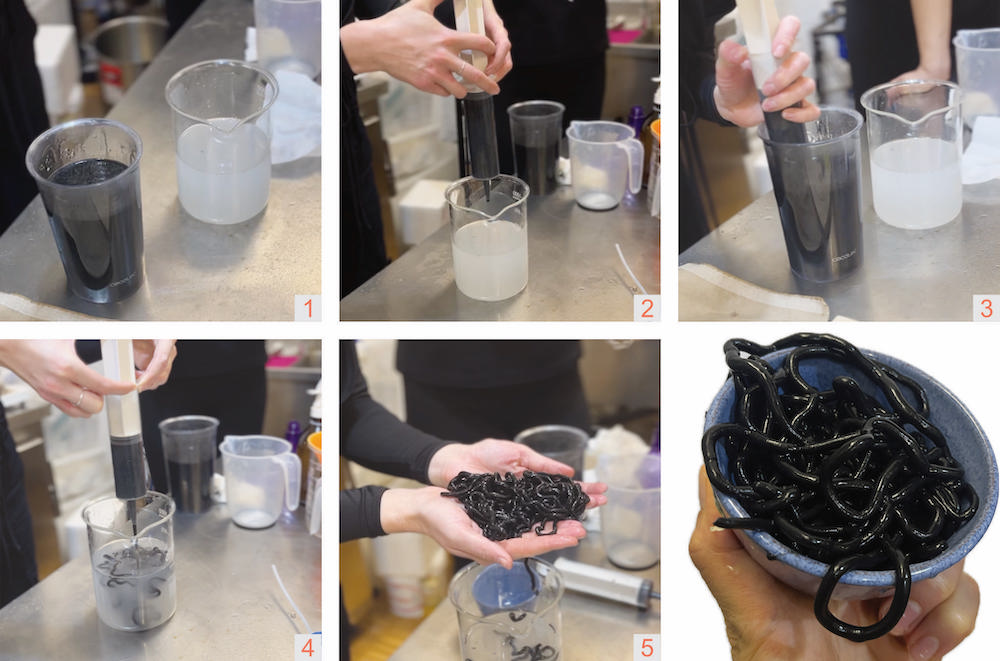
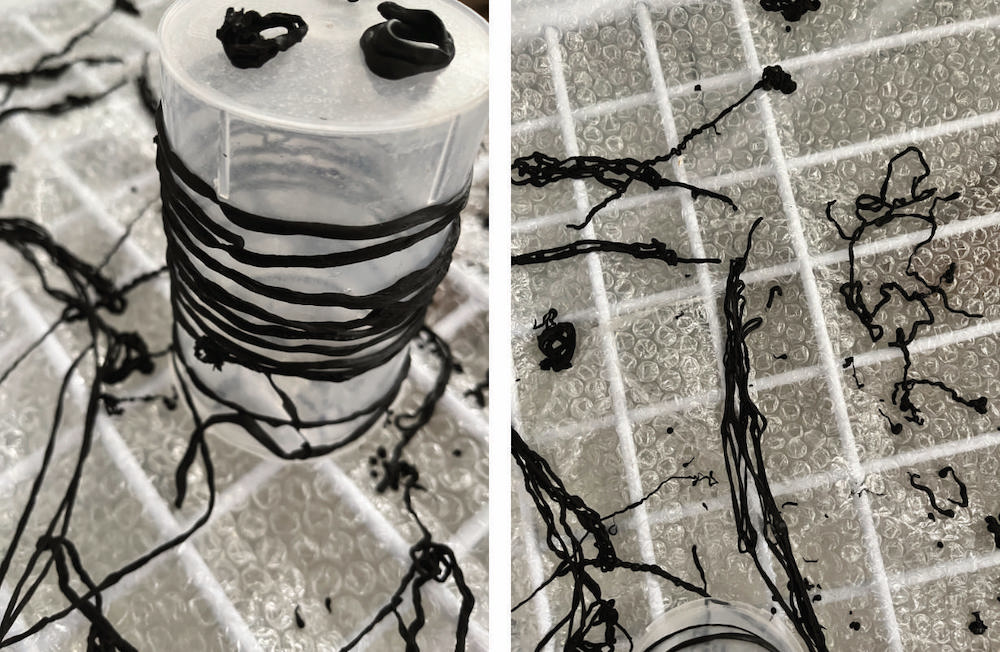
EXPERIMENTING WITH DYE BATH FROM THE BIOCHROME WEEK.
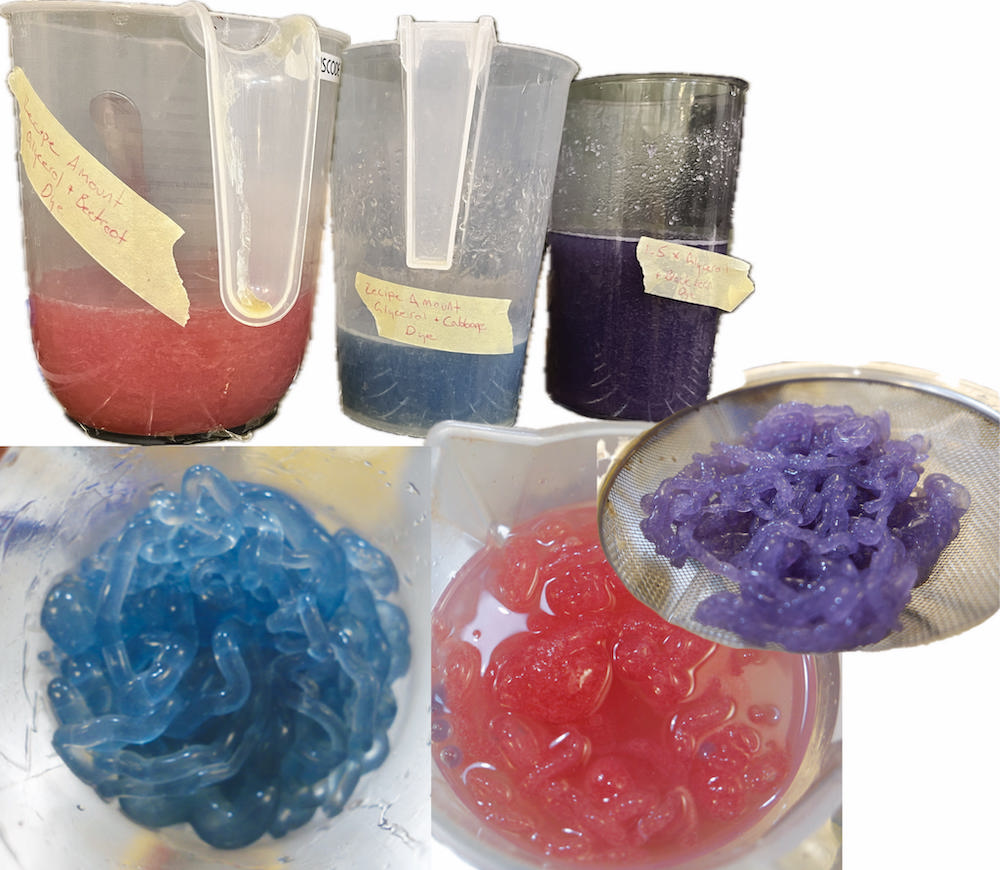
| Material pic | COLORANT | plastifier |
|---|---|---|
 |
Cabbage iron | glycerol |
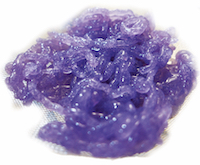 |
Beetroot vinegar | glycerol |
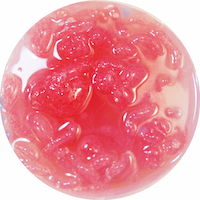 |
Bean & Allum | glycerol |
 |
Activated charcoal | glycerol |
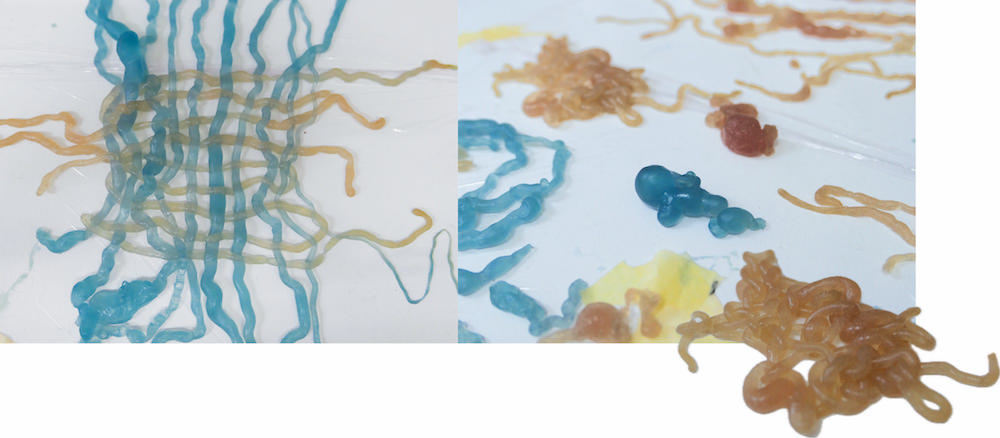
SODIUM ALGINATE (casting)¶
- We added Spirulina and Mica powders to experiment with the color change.
* 4g Sodium alginate
* 200 ml Water
* 10g - 30g Glycerol (according to the required flexibility)
* 30g Calcium chloride
* 300ml water
* Breathable mold (wood, fabrics, textile mesh)
* Syringe, spoon, etc.
* Cups
* Mixing tools
* Measure the Sodium alginate, glycerol and water and mix it.
* Measure the Calcium chloride and water and mix and put in a spray bottle.
* Spray the mould with Calcium chloride and then pour the Sodium alginate into the mold.
* Spray with Calcium chloride solution and wait for it to dry.
* After a day of few hours you can flip it and spray the other side, repeat until it hardens.
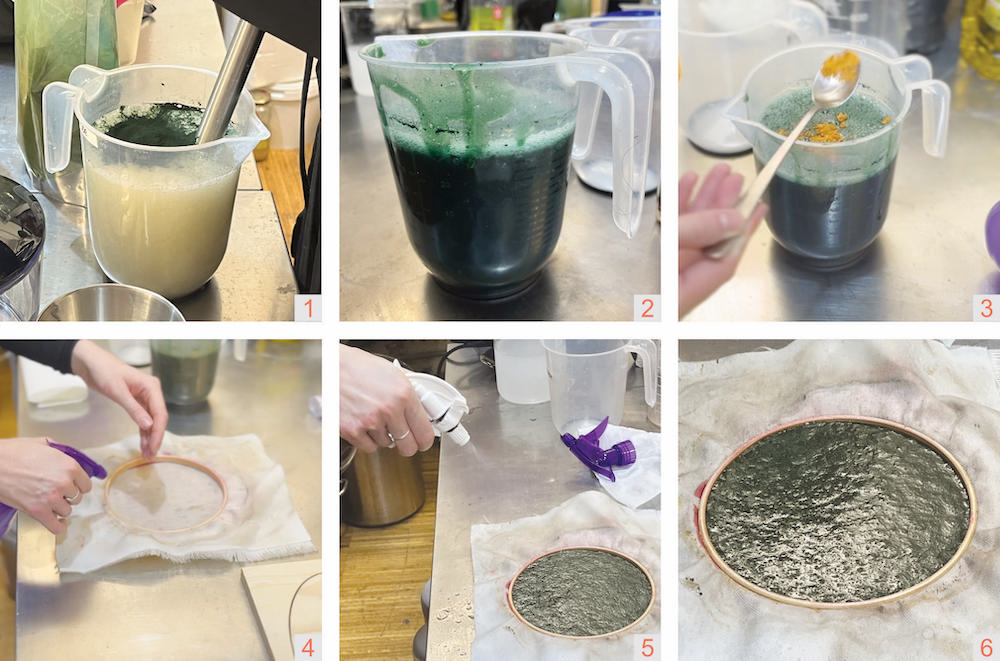
Hala Amer was working with alginate and carrots.
| Leather // Carrot // Sodium Alginate | Recipe above. Chopped carrots with sodium alginate mixture with glycerol for flexibility. |

GELATIN BASED¶
Animal derived ingredient made from collagen present in animal parts.
| Water Resistance | Takes a couple of hours before dissolving in water. |
| Heat Resistance | Not heat resistant at all. Begins melting at 50 degrees celsius. |
∙ 48g Gelatine
∙ 240ml water
∙ Glycerol - Rigid:0g; Normal:24g; Elastic: 48g
∙ Molds (3D printed molds, embroidery hoops, textured foils / fabircs)
∙ Pots and stovetop
∙ Mixing tools (spatula, cooking spoon, fork)
∙ Bowls for weighing
∙ digital weighing scale
∙ Measure out your ingredients
∙ Add the water and gelatin together in the pot and mix well
∙ Add the glycerin and heat mixture until it starts bubbling, stirring constantly
∙ Pour mixture into a mold (let it cool for a bit if the mold is not heat resistant)
∙ Let the material dry in the mold for a few days

EXPERIMENTING WITH GELATIN BASED RECIPES¶
-
Adding spirulina as an colorant.
-
Adding activated charcoal as an colorant and for electrical conductivity.
-
We also experimented with our pigments from biochromes week.
-
Using holographic foil.
GELATIN AND SPIRULINA
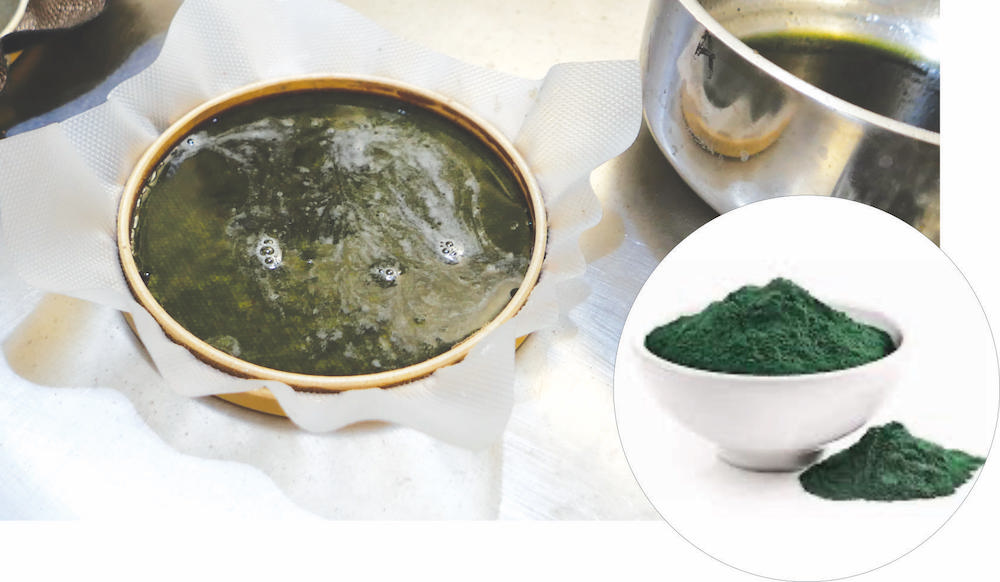

GELATIN AND CABBAGE & IRON DYE BATH
- We also tryed to pour conductive threads.
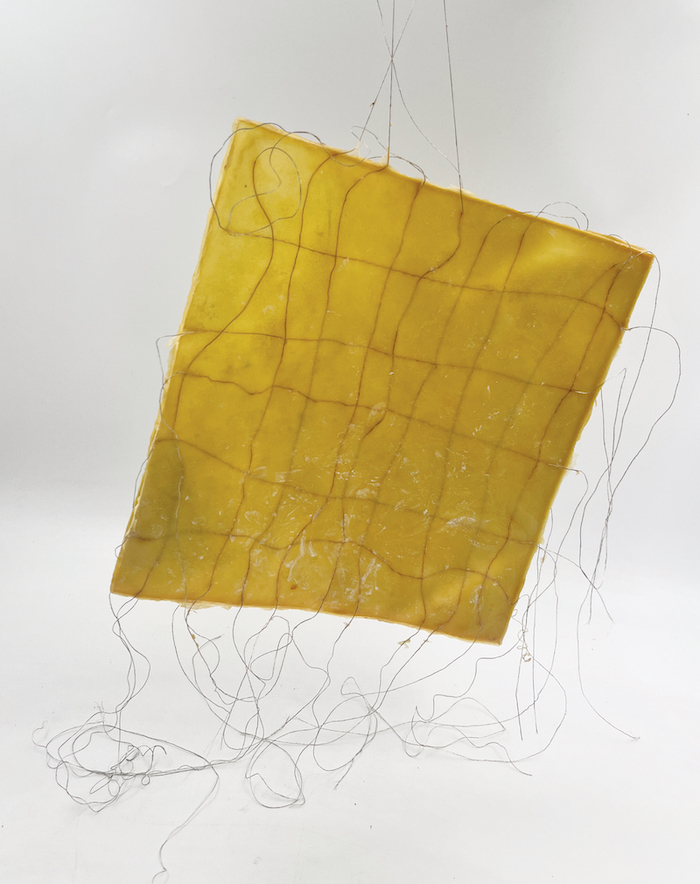

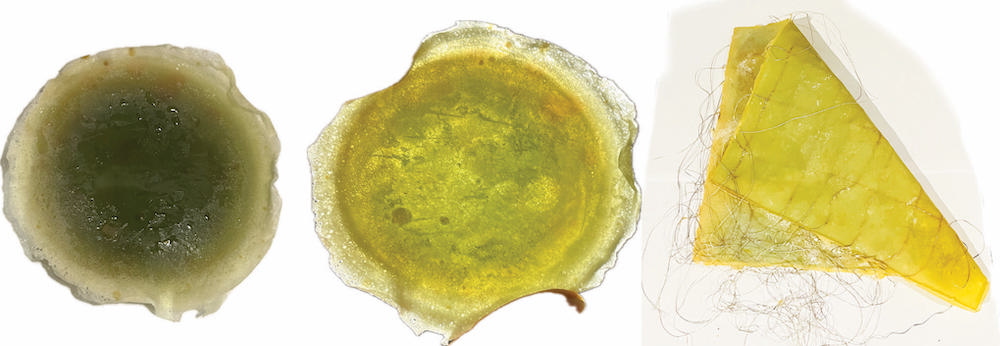
GELATIN AND ACTIVATED CHARCOAL

HOLOGRAPHIC FOIL
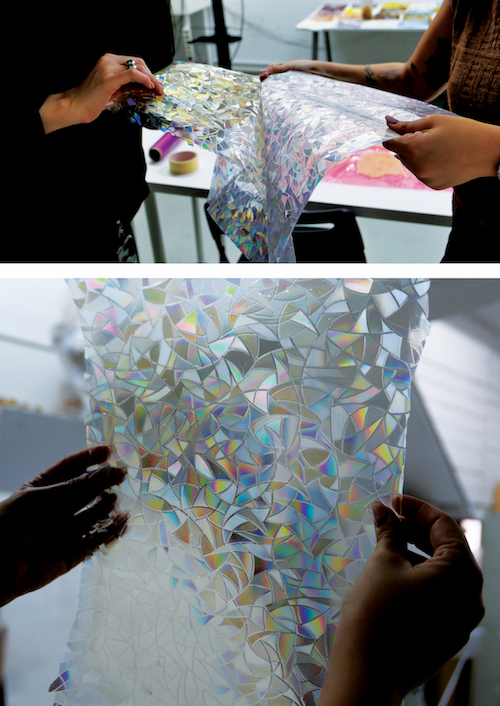
GELATIN AND CABBAGE ALUM PIGMENT
- Elastic gelatin, the pigment is not dissolved but makes texture, we also made the brown pieces by accident. There was some material in the pot that got burn.
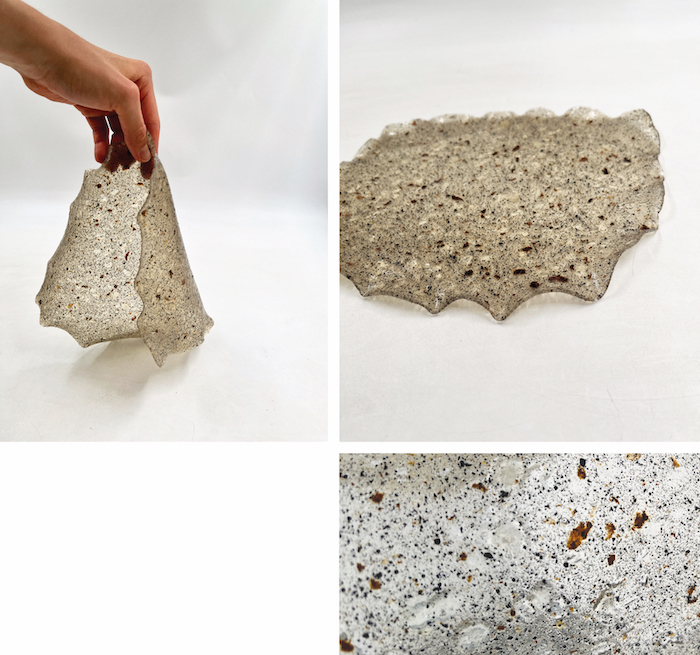
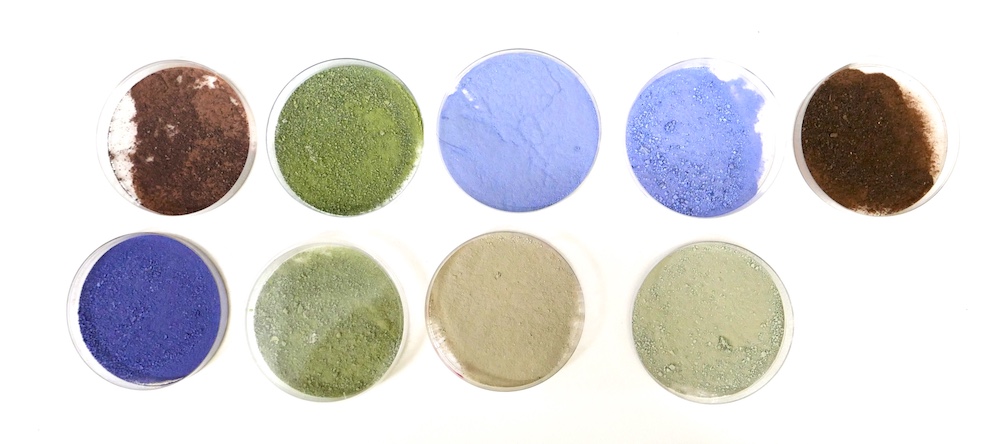
AGAR AGAR BASED¶
A jelly-like substance obtained from red algae. "Agar is a mixture of two components: the linear polysaccharide agarose, and a heterogenous mixture of smaller molecules called agaropectin. Agar is a compoind known as a polysaccharide." (Credit Material Archive TextileLab Amsterdam)
Special Characteristic:¶
| Water Resistance | It dissolves in room temperature water in a few hours and hot water immediately. |
| Heat Resistance | Not heat resistant. Best for short term use. |
∙ 10g agar
∙ 300ml water
∙ Glycerol - Rigid: 4g, Normal: 16g, Elastic: 32g (depending on rigidity/flexibility)
∙ Molds (embroidery hoops, textured paper, 3D printed molds)
∙ Pots and stovetop
∙ Mixing tools (spatula, cooking spoon, fork)
∙ Spatula or squeegee
∙ digital weighing scale
∙ Measure the ingredients.
∙ Add all in a pot and mix well
∙ Heat the mixture until it starts bubbling while stirring constantly.
∙ Pour mixture into a mold (let it cool for a bit before if the mold is not heat resistant)
∙ Let the material dry in the mold for a few days, or you can also speed up the process and use a dryer or oven but on a low temperature.
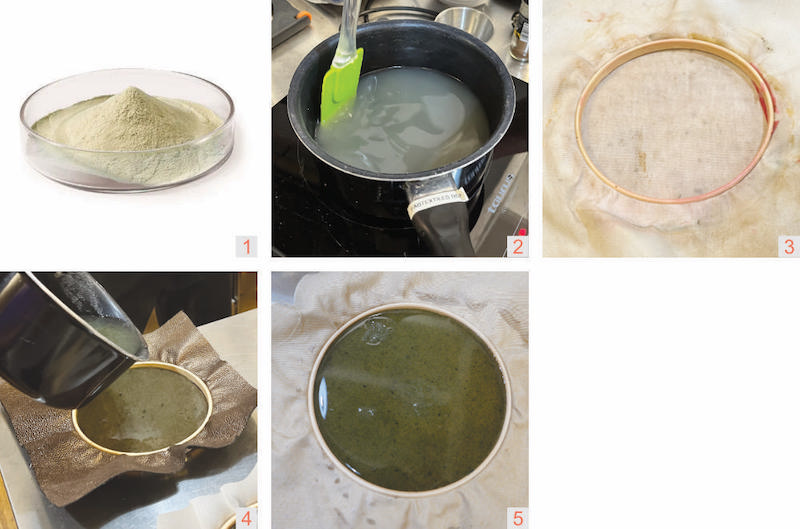
| Agar agar // Glycerol // | |
| Based on recipe above, but in or to achieve "super elastic", add 48g Glycerol (initially elastic one 32g Glycerol), lay it on a flexible plastic sheet and try shaping it by rolling while it's partially dry. |  |
AGAR AGAR AND ACTIVATED CHARCOAL
PINE RESIN¶
∙ 45g pine resin
∙ 20ml ethanol
∙ 5gr carnuba wax
∙ Molds
∙ Pots and stovetop
∙ Mixing tools (spatula, cooking spoon, fork)
∙ Spatula or squeegee
∙ digital weighing scale
1. Prepare all the necessary materials and ingredients.
2. Place baking paper on the bottom part of the mold and press it to fit the shape. Keep aside a piece of baking paper to use as the top cover.
3. Melt the pine resin and mix it with the Carnauba wax. Melt them together.
4. Add alcohol to the mixture and mix well. Be careful not to inhale the vapors.
5. Add the filler material and mix everything together.
6. Quickly pour the mixture into the mold using a spatula.
7. Cover the top with the baking paper.
8. Press the mixture down with your hands and then with the top mold to distribute the mix and compact it.
9. Let the mixture cool down for approximately 15 minutes.
10. Remove the baking paper and the mold.

MYCELIUM¶

∙ Substrate amount dependent on size of your piece
∙ 60% WOS (weight of substrate) of sculpting mix
∙ Water
∙ Living mycelium block
∙ Bowls
∙ Plastic wrap
∙ Alcohol, gloves, mask, laboratory coat
∙ Mold
∙ To get started with your substrate preparation, first measure out the substrate in grams and then measure 60% of that amount of sculpting mix. ∙ Combine both with some water and mix until the texture becomes chunky and pasty. ∙ Next, in a sterile environment, take a piece from your "mother" mycelium block and add it to the mix. ∙ Prepare your mold by covering it with sterile plastic wrap or sterilizing it thoroughly. ∙ Then, press your mix into the mold and cover the entire thing with plastic wrap. ∙ Poke some holes using a needle to allow some air flow, and finally, leave it in a clean place and wait for it to grow.
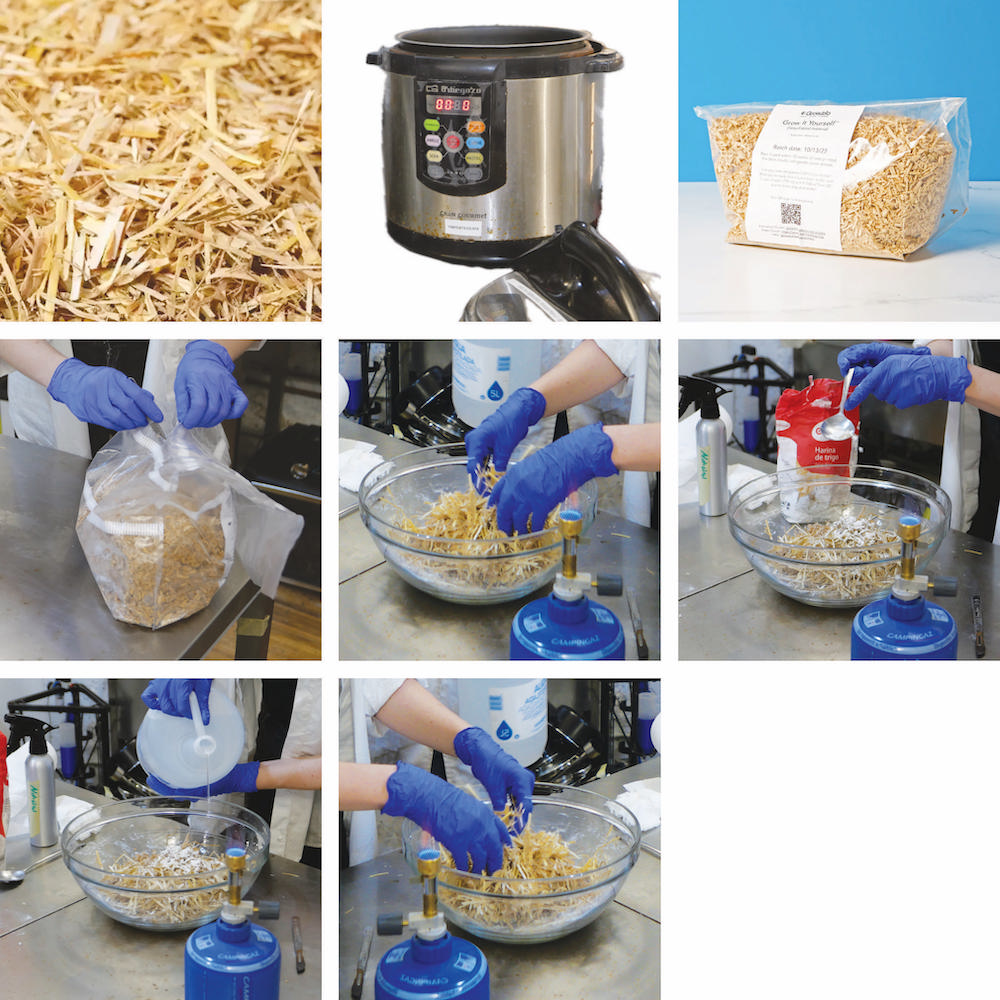
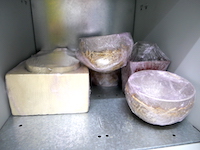
FINAL RESULTS¶

BANANA BIO-LEATHER¶

- The idea is to upcycle banana peels into an eco-friendly and natural product. For a week, I collected banana peels and stored them in a freezer. I did some research on banana leather recipes and existing products to get some inspiration and knowledge.
- I decided to try to get inspiration from Emma's recipe for using apple peels using carnuba wax.
- We had some mandarin peels in the lab, so I decided to combine them with banana peels.
∙ 452gr defrosted banana peels
∙ 100gr mandarin peels
∙ A little bit of water
∙ 20gr Carnauba wax
∙ 1 Tea spoon of cinnamon
I divided the recipe into two amounts to test one sample without Glycerol.
∙ 367gr (defrosted banana peels + orange peels)
∙ 40gr Glycerol
∙ Digital scale
∙ Cooking stove
∙ Pot
∙ Mold with fabric / mold with plastic sheet
∙ Spatula, cooking spoon
∙ Blender
∙ Oven 60ºC
∙ Take out the banana peels from the freeze and prepare fresh mandarin peels.
∙ Measure the peels and calculate the rest of the ingredients you will need.
∙ Simmer the ingredients in a pot slowly.
∙ Add the cinnamon and carnauba wax, splash of water if you need (to prevent burning).
∙ Simmer the mix during 20-30'. Do not let it boil.
∙ After after softening blend it until it takes a pate texture.
∙ Pour the mix in the mold.
∙ Smooth the surface with a spatula.
∙ Let it dry dry on air and finish it baking in the oven for 60ºC (if possible 45ºC) during about 2 hours, but be careful of burning.
∙The best way is to let it dry in the dehydrate machine (35ºC) for about 6h to accelerate the process. But I let it dry completely on air.

| BANANA BIO-LEATHER - with Glycerol | BANANA BIO-MATERIAL - no Glycerol |
|---|---|
| Flexible material almost like thicker leather. | Quite rigid and inflexible material |

- Banana biomaterial without plastifier.
- Experimenting with mica powders. Mica powders are fine, dry, and often sparkly or shimmering substances made from mica mineral flakes. Mica is a group of silicate minerals that can be naturally occurring or synthetically produced.
| Material pic | COLORANT | plastifier |
|---|---|---|
 |
mica powder gold | glycerol |
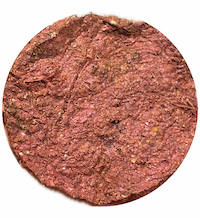 |
mica powder rosa | glycerol |
CHAMPIGNON BIO-LEATHER¶

During my previous project that involved mycelium, I found myself in a situation where I had accumulated so many bags of substrate that I couldn't process them all. The oyster mushrooms were thriving under the conditions, and I ended up with a massive harvest of mushroom fruits. At first, my family and I were overjoyed, but as time passed, our taste for mushroom-based dishes began to wane. That's when it occurred to me that it would be great to make some material from the fresh fruiting bodies.
However, due to my busy schedule, I was only able to dry them, and I never got around to actually producing the material. The recipe was in my head, and now I finally had the opportunity to work on it. I was particularly interested in exploring whether Champignon mushrooms could be used to create such material. Unfortunately, their mycelium doesn't form a solid block, which makes them less useful in the field of material engineering. Nevertheless, this is one of the ways I could make use of mushrooms in materials.
I searched the web for recipes that could transform mushrooms into bioplastics, but I couldn't find any that used the same technique as mine. However, I was inspired by a method that involves creating paper from fresh mushroom fruiting bodies.

- Preparation of paper from champignon mushrooms
- I found just one example which was similar to my idea @Mycelium_25
- Making Mushroom Paper
∙ 10g agar
∙ 200 ml water
∙ 300g fresh Champignon
∙ Glycerol - 18g, (you can experiment - depending on rigidity/flexibility)
∙ Molds (embroidery hoops with textile)
∙ Pots and stovetop
∙ Mixing tools (spatula, cooking spoon, fork)
∙ Spatula or squeegee
∙ digital weighing scale
∙ Measure the ingredients and calculate the rest of the ingredients you will need.
∙ Add champignons and water in a pot and mix well.
∙ Heat the mixture until it starts bubbling while stirring constantly.
∙ After after softening the champignon blend it until it takes a pate texture (a little water will evaporate, that's fine).
∙ Pour the blended mixture into a pot again and add glycerol and agar. wait until the mixture starts to thicken a little.
∙ Pour mixture into a mold (let it cool for a bit before if the mold is not heat resistant)
∙ Let the material dry in the mold for a few days, or you can also speed up the process and use a dryer or oven but on a low temperature. The material was still wet after two days so I tryed to put it into the oven for 60ºC about 2 hours and it worked.
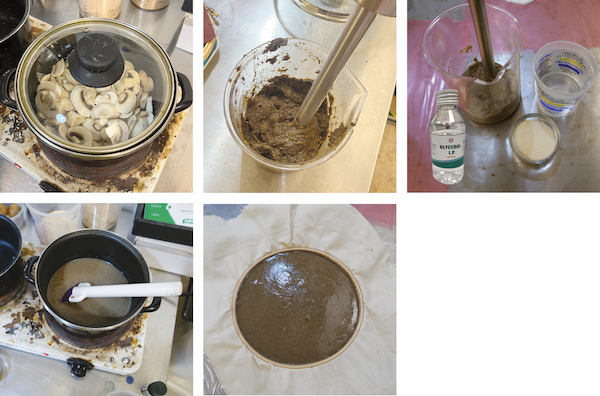
- I concentrated on two different levels of thickness.
| THICK | THIN |
|---|---|
| Flexible material almost like thicker leather. | Flexibility increases with decreasing thickness |

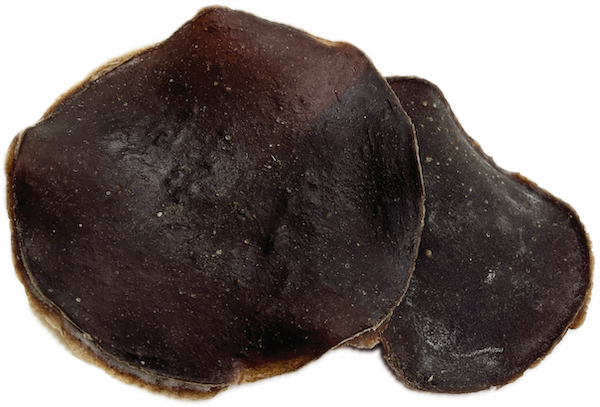
OVERVIEW MATERIAL RESEARCH OUTCOMES¶
AGAR BASED¶
Agar Agar // Stretch Foil¶
 Using the stretch Bio-Foil recipe from the Global Lecture and pouring out a think layer.
Using the stretch Bio-Foil recipe from the Global Lecture and pouring out a think layer.
Agar Agar // Flexible Foil¶
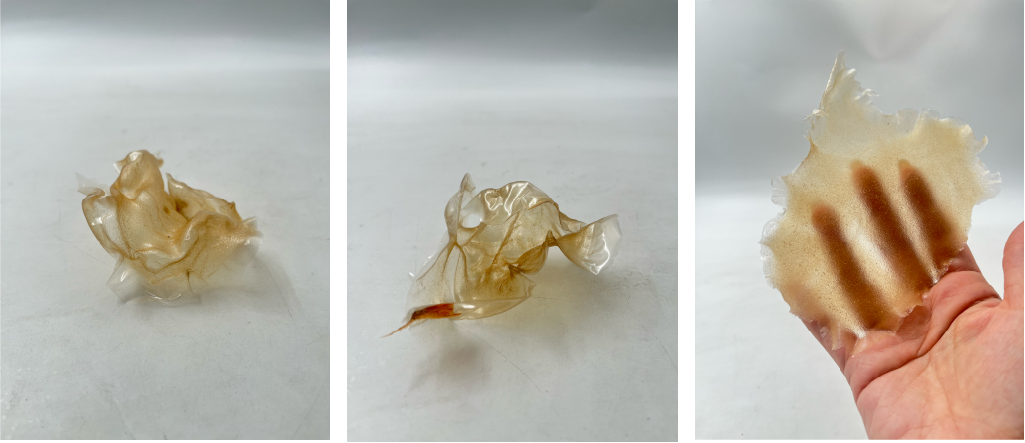 Using the flexible Bio-Foild recipe from the Global Lecture. Starting with no glycerol until 6g of glycerol (left to right).
Using the flexible Bio-Foild recipe from the Global Lecture. Starting with no glycerol until 6g of glycerol (left to right).
Agar Agar // Eggshells¶
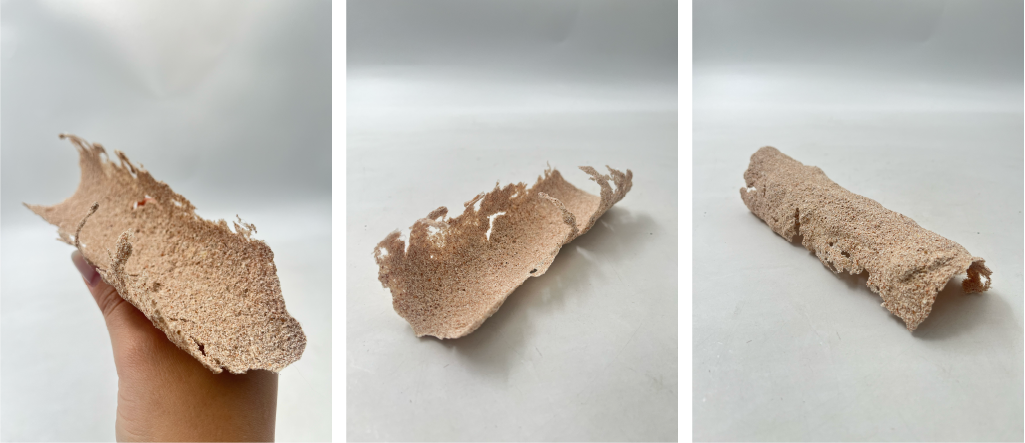 Letting the agar become more viscous before adding the eggshells into the mixture. Puring it on a circular wooden surface and allowing it to dry on it.
Letting the agar become more viscous before adding the eggshells into the mixture. Puring it on a circular wooden surface and allowing it to dry on it.
Agar Agar // Foam¶
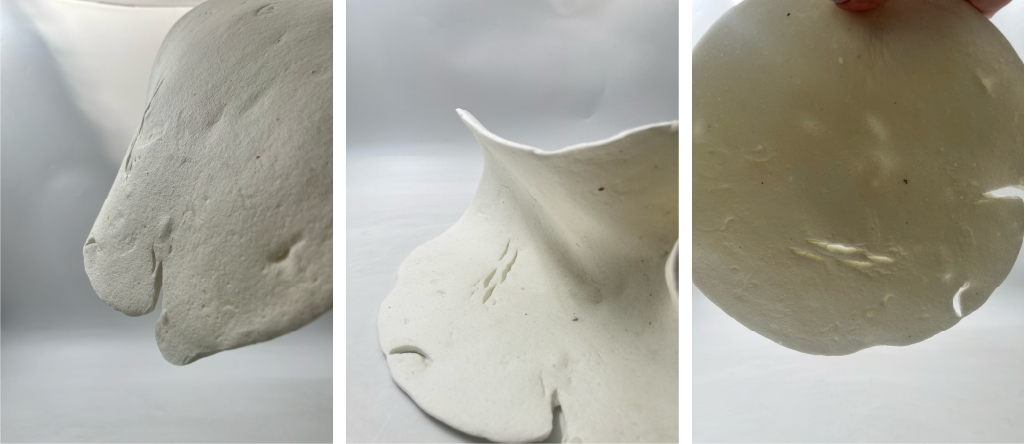 Whisking the regular agar recipe with soap to make a foam.
Whisking the regular agar recipe with soap to make a foam.
GELATINE BASED¶
Gelatine // Foam // Flexible // Dye Bath¶
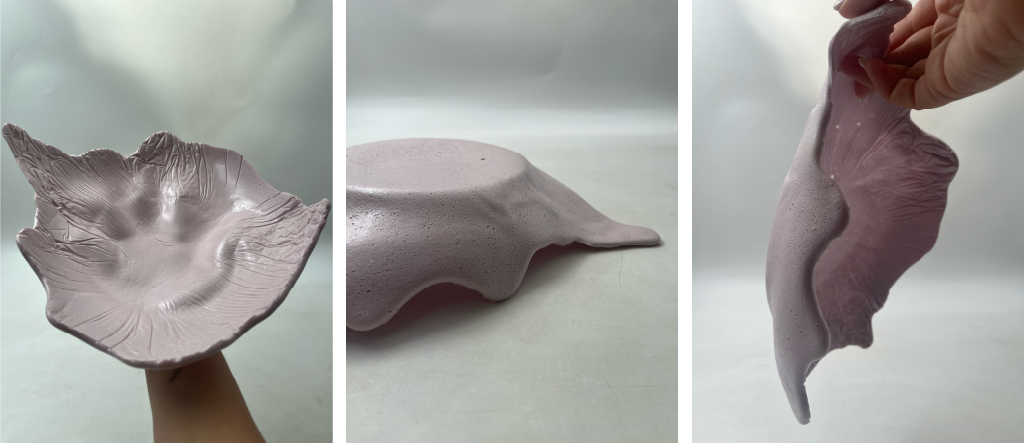 Using a dye bath instead of regular water and making a flexible gelatine mixture. Once cooled down, its whisked to create a foam.
Using a dye bath instead of regular water and making a flexible gelatine mixture. Once cooled down, its whisked to create a foam.
Gelatine // Foam // Cabbage Dye Bath // Strings¶
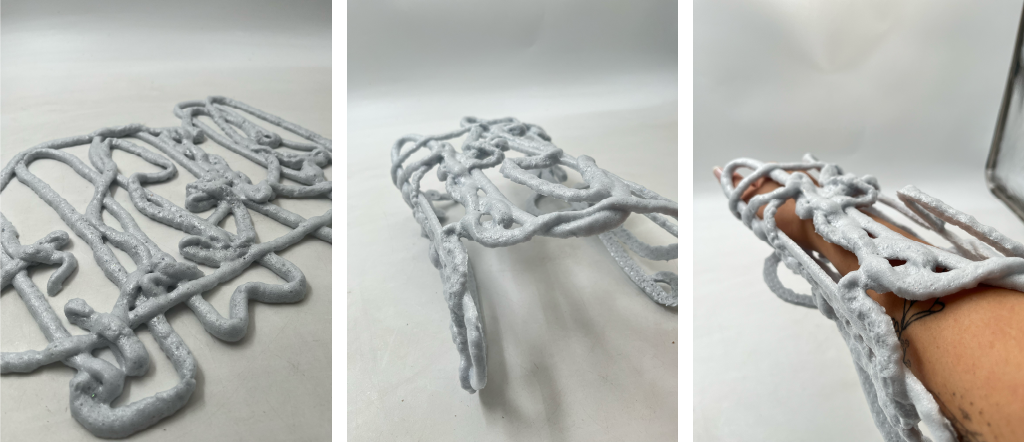 Using a dye bath instead of regular water and making a flexible gelatine mixture. Once cooled down, its whisked to create a foam.
Using a dye bath instead of regular water and making a flexible gelatine mixture. Once cooled down, its whisked to create a foam.
-
Using less Glycerol, 10g to 400ml of water.
-
Using a plastic bag, pouring it out strings in shapes.
Gelatine // Foam // Cabbage Dye Bath¶
 Using a dye bath instead of regular water and making a flexible gelatine mixture. Once cooled down, its whisked to create a foam.
Using a dye bath instead of regular water and making a flexible gelatine mixture. Once cooled down, its whisked to create a foam.
Using less Glycerol, 10g to 400ml of water.
Pouring out a large blob. Resembles memory foam and goes back to shape in a few minutes.
ALGINATE BASED¶
Alginate // Foam // Charcoal¶
 Adding charcoal to the sodium alginate mixture. After allowing it to cool, whisking it to make foam.
Adding charcoal to the sodium alginate mixture. After allowing it to cool, whisking it to make foam.
Alginate // Foam // Spirulina¶
 Adding spirulina to the sodium alginate mixture. After allowing it to cool, whisking it to make foam. Once casted, a lasercut pattern is placed on top to get the shape.
Adding spirulina to the sodium alginate mixture. After allowing it to cool, whisking it to make foam. Once casted, a lasercut pattern is placed on top to get the shape.
Leather // Carrot // Sodium Alginate¶
 Recipe above. Chopped carrots with sodium alginate mixture with glycerol for flexibility.
Recipe above. Chopped carrots with sodium alginate mixture with glycerol for flexibility.
FOams¶
We researched various foam materials, especially Julja focused on these recipes, which will be more detailed and available on her website.
Gelatine/ Foam/ Rigid
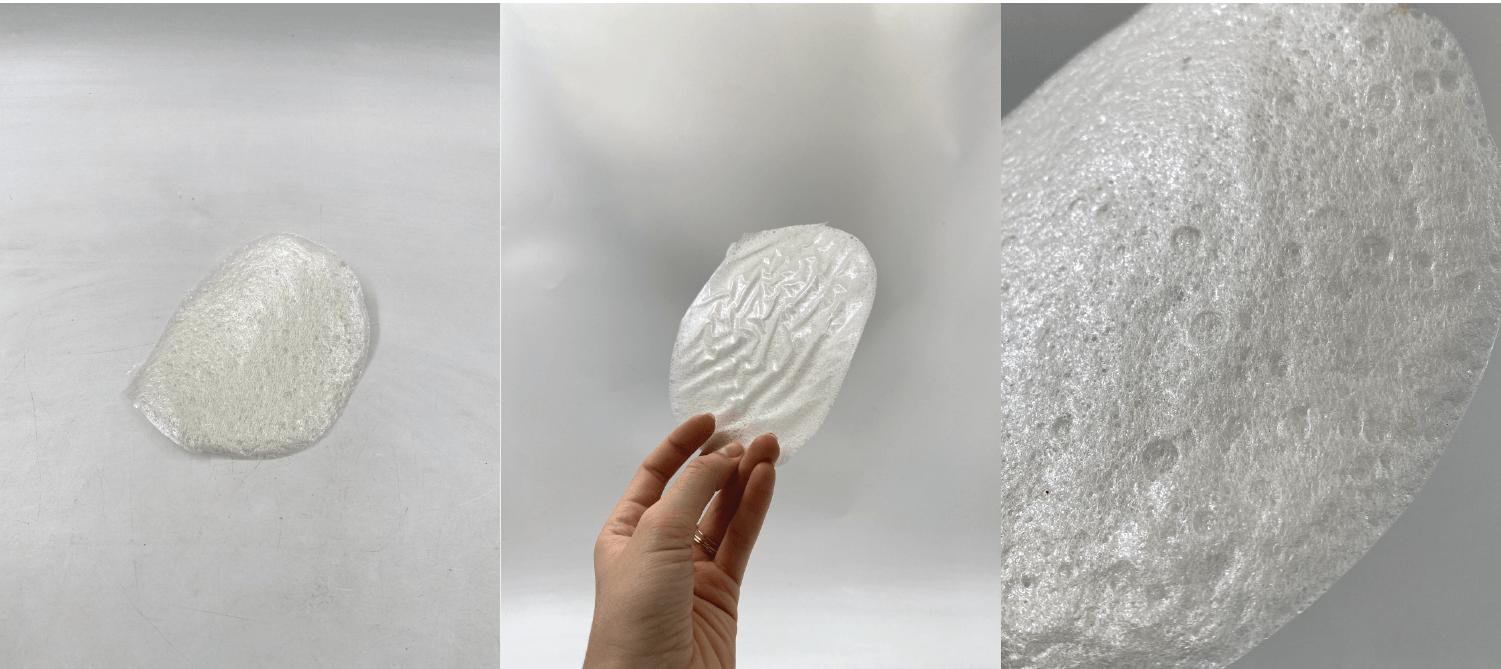
- For the expansion of the biomas soap is added to the mixture. This experiment was conducted to see how well can gelatine foam without any additives.
Gelatine/ Soap/ Foam/ Rigid
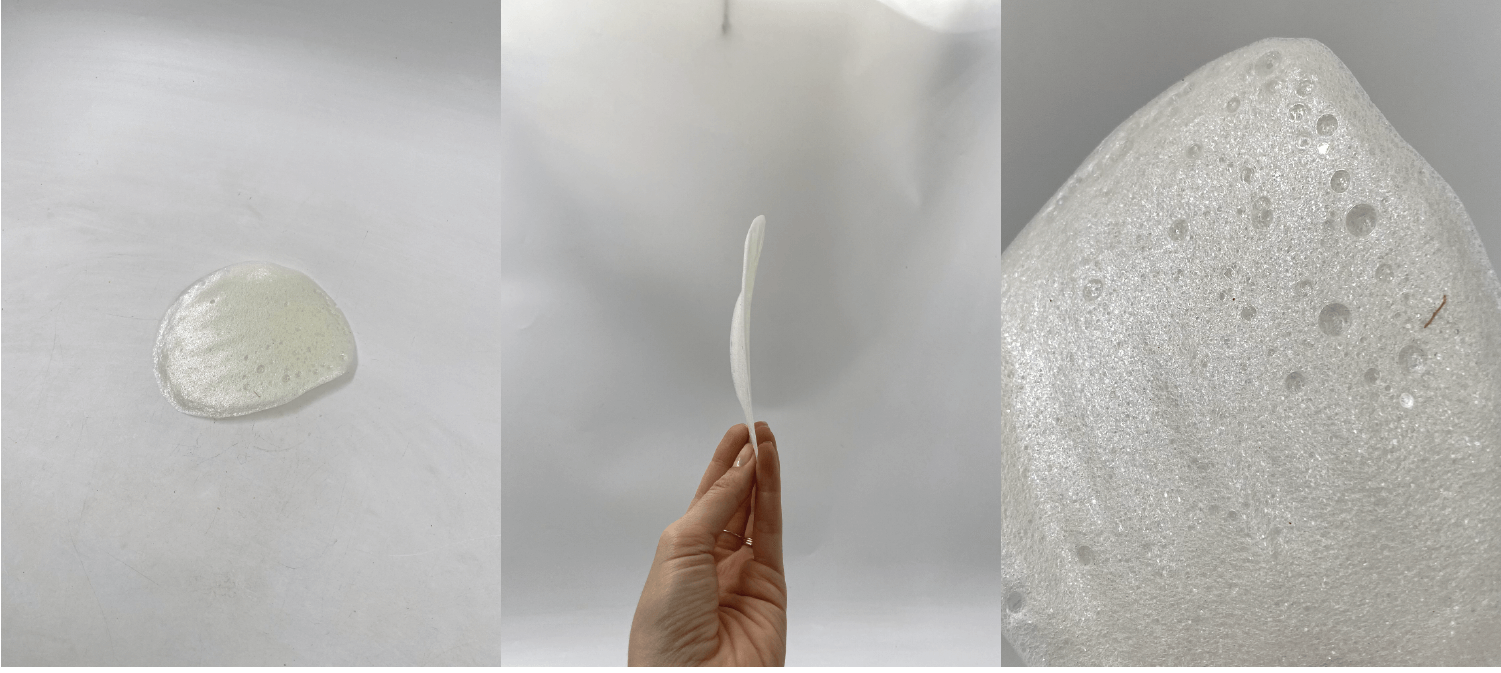
- Adding soap to the mixture creates a denser foam. The sample also bend while it was dryin. That might happened because no glicerin was added.
Gelatine/ Soap/ Glycerol/ Foam/ Soft
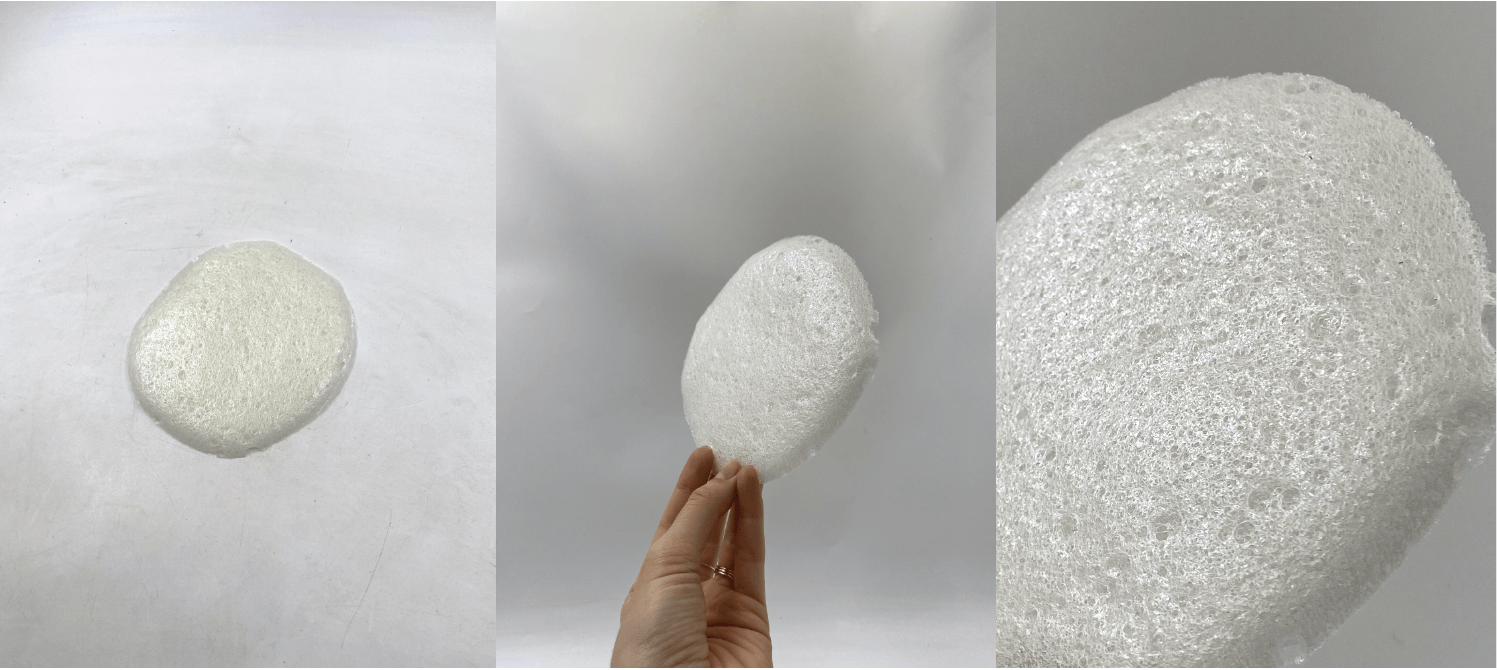
- A denser, more soft foam sample.
Gelatine/ Soap/ Glycerol/ Foam/ Soft
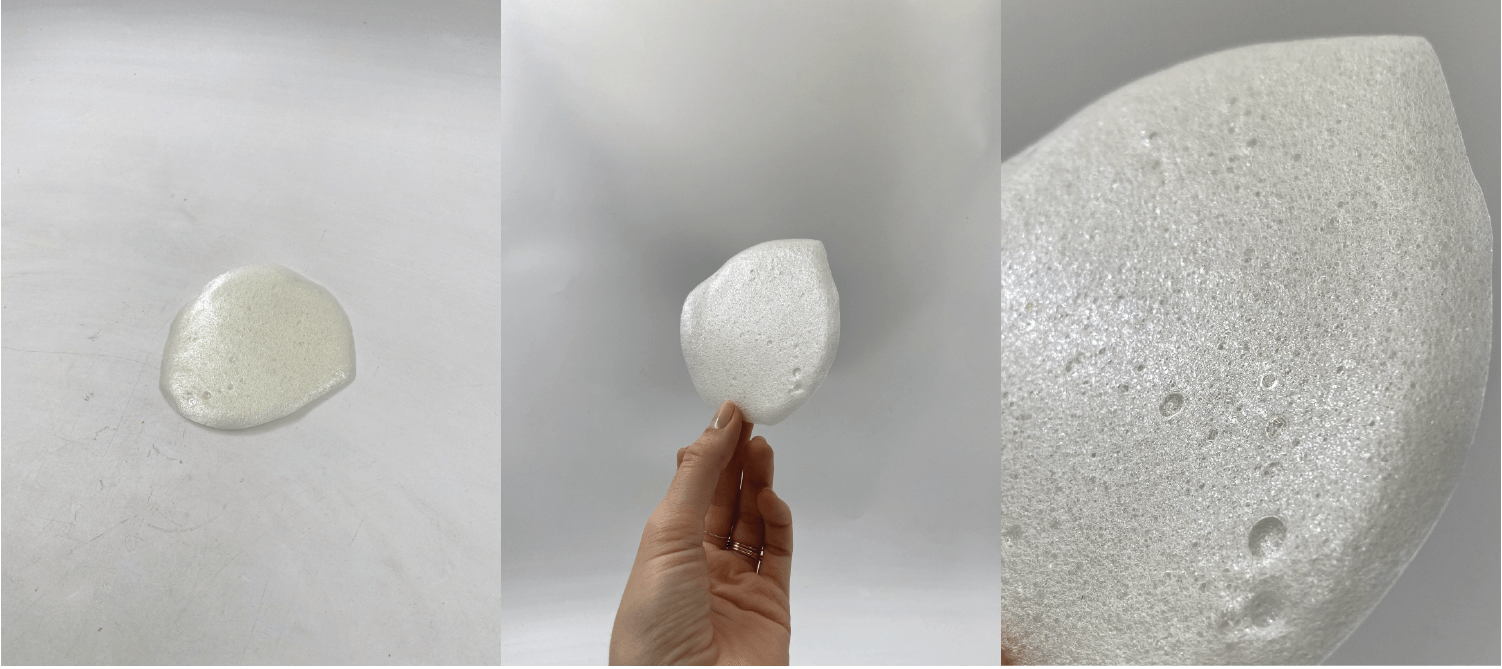
- A denser, soft foam sample. Whisking time of the biomass was longer.
Gelatine/ Soap/ Glycerol/ Foam/ Soft

- Air injected foam sample. After whisking, air bubbles were injected into the mixture.
Gelatine/ Soap/ Glycerol/ Charcoal/ Foam/ Soft and rigid
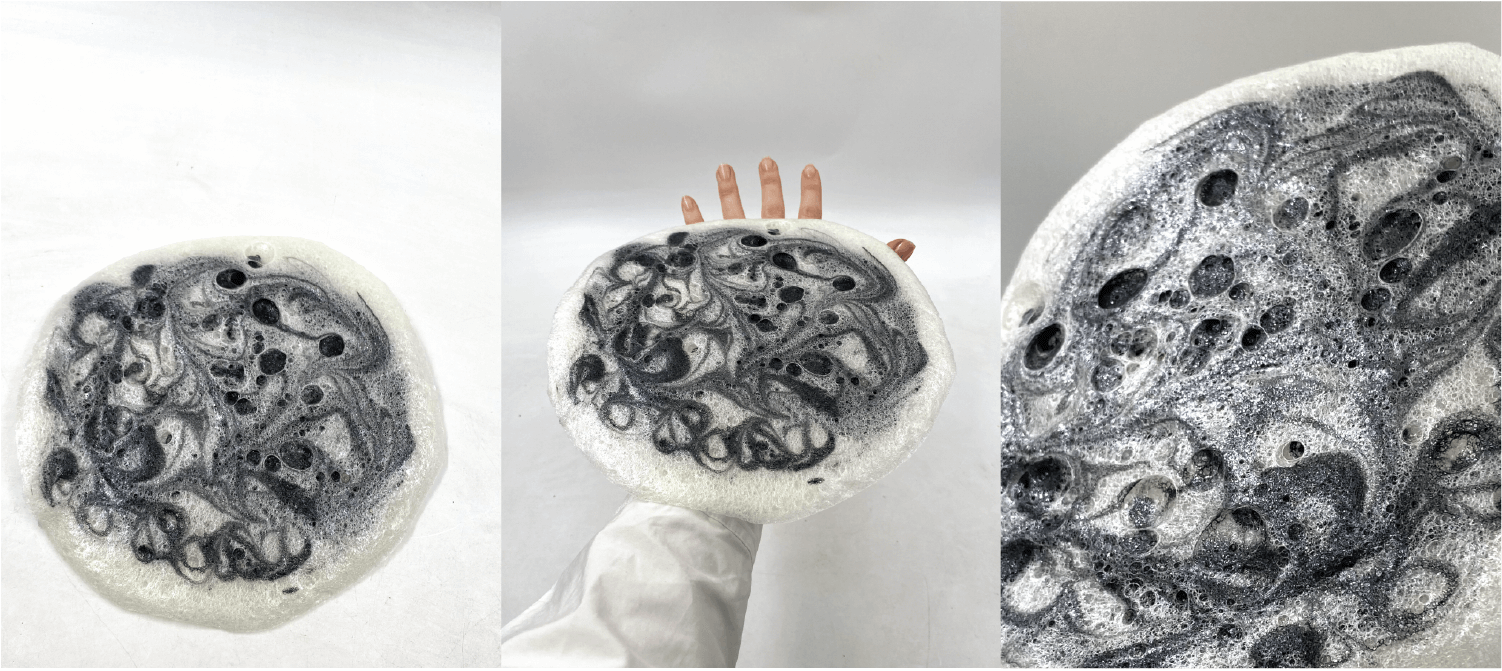
- Sample made with charcoal biofoam and 'regular' one. The sample was made to experiment with patterns and aesthetics.
Gelatine/ Soap/ Charcoal/ Foam/ Rigid/ Light
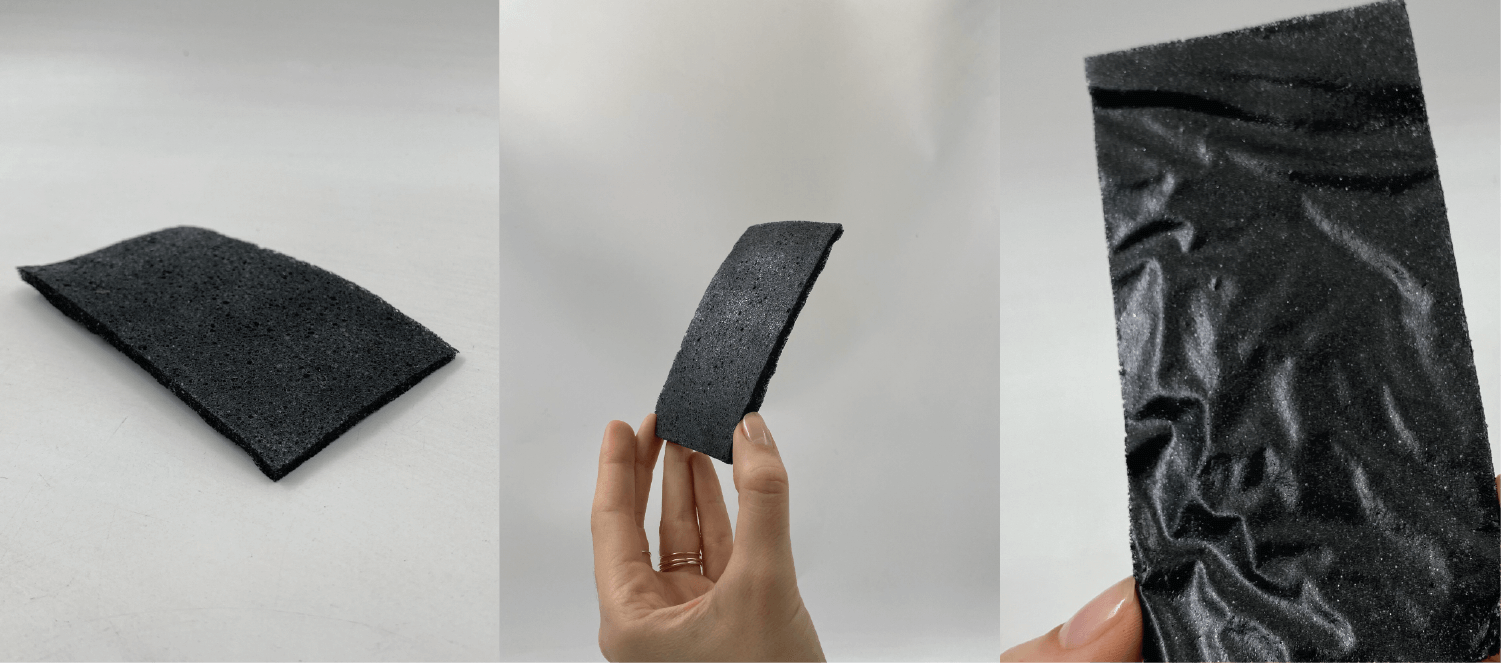
- A rigid but very light sample of biofoam with charcoal.
Gelatine/ Soap/ Charcoal/ Foam to Chalk-like/ Rigid/ Light

- If a lot of charcoal is added to the mixture of a biomass, the final material can be conductive. This was the first sample to try that. Unfortunately, it wasn't conductive. It would be nice to make another sample with some metal powders.
Gelatine/ Soap/ Wool/ Fabric Foam/ Rigid/ Light - and not dried yet

- A sample with mixing wool into the biofoam was conducted out of pure experimentation. An idea was to create a hard and thick but light foam. Because of the thickness of the wet sample, bottom side has not been able to dry appropriately and some of the fabrics fell out. No glycerol was added to the mixture.
Gelatine/ Soap/ Glycerol/ Charcoal/Wool/ Fabric/ Foam brick/ Light, rough
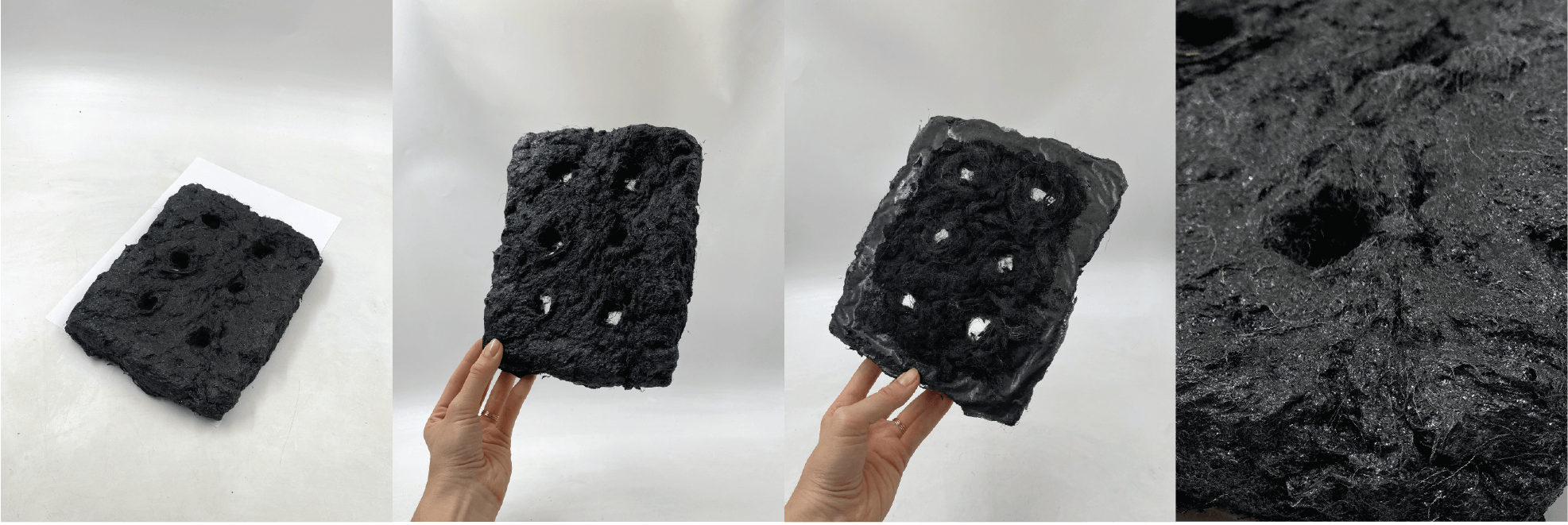
- A biofoam wool brick. Experimenting with different types and consistency of materials used: biofoam, wool fabrics, charcoal powder.